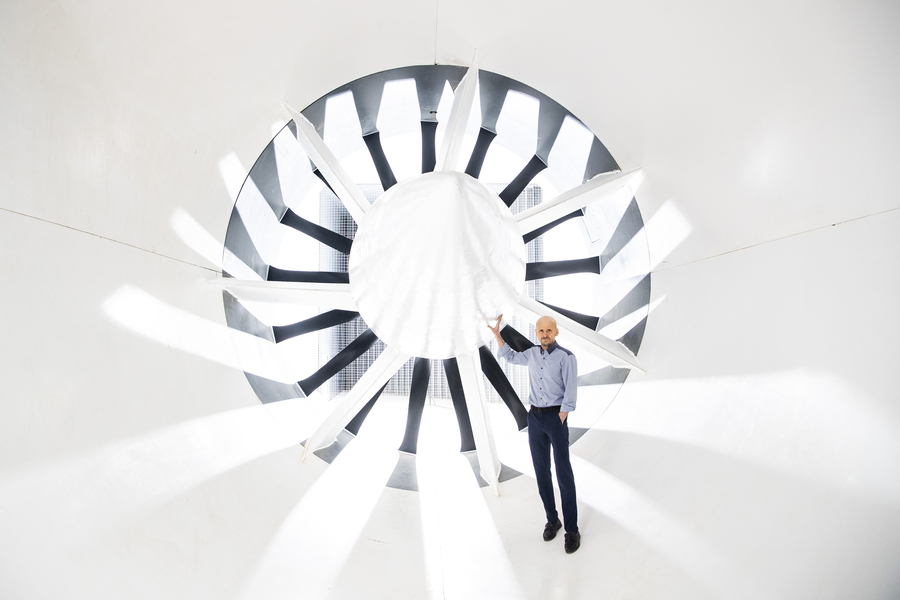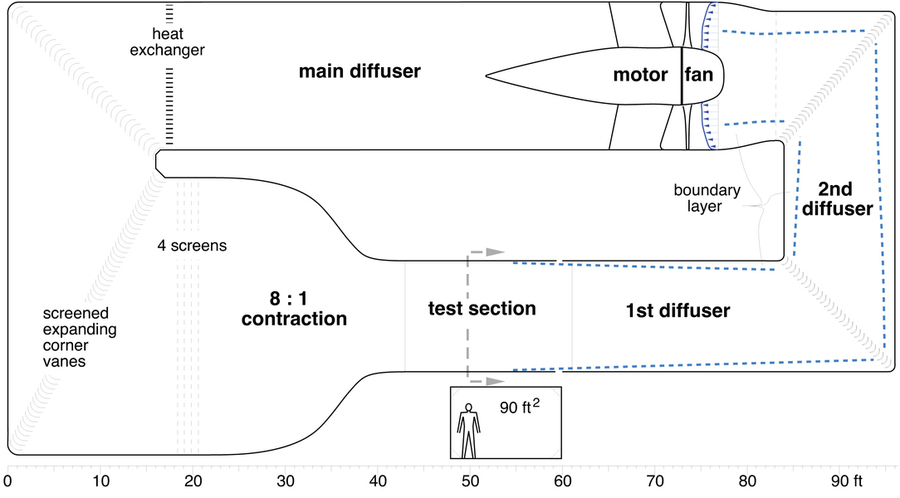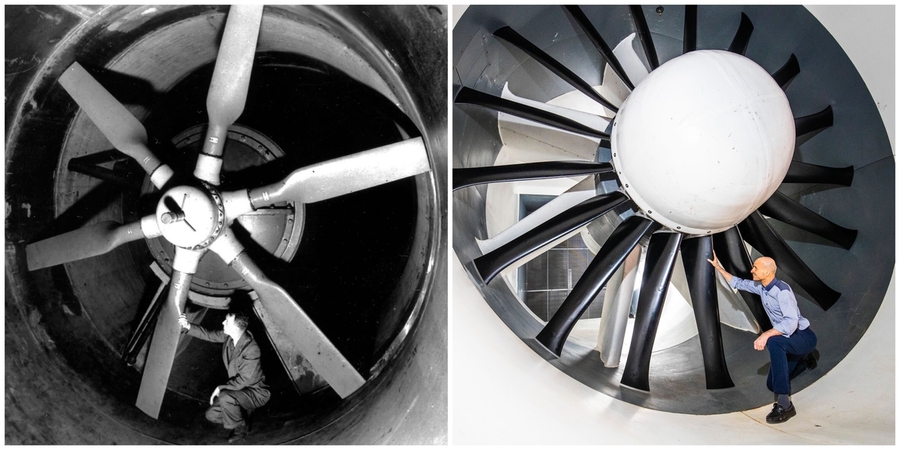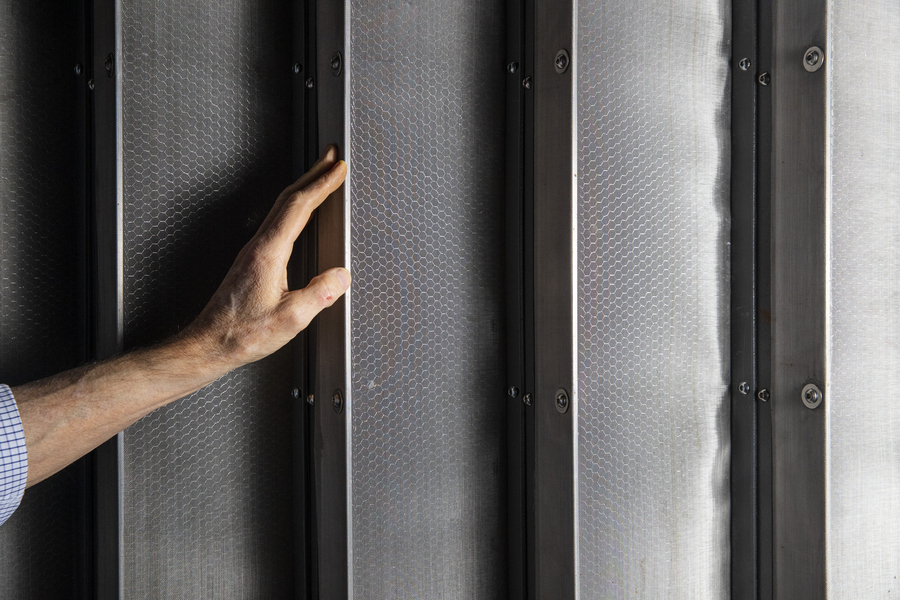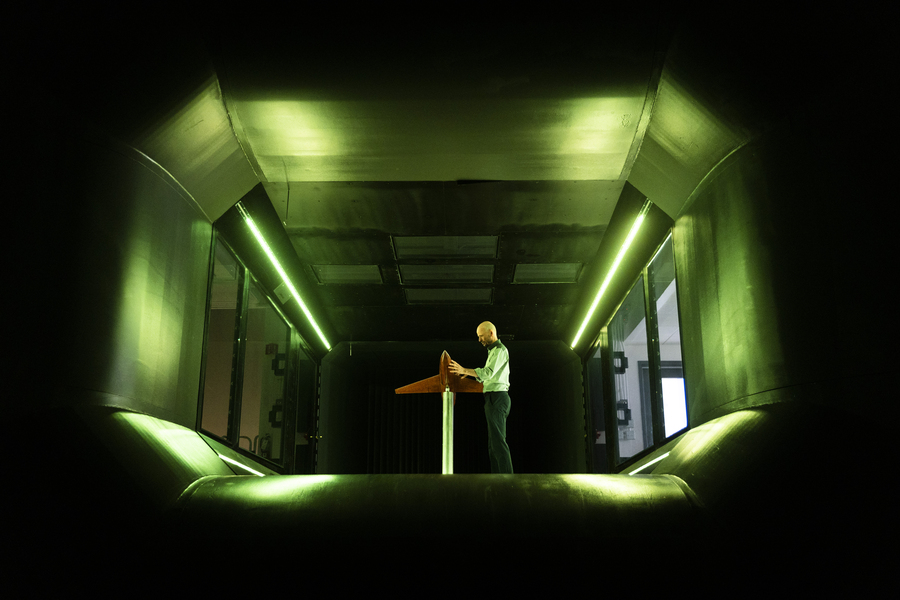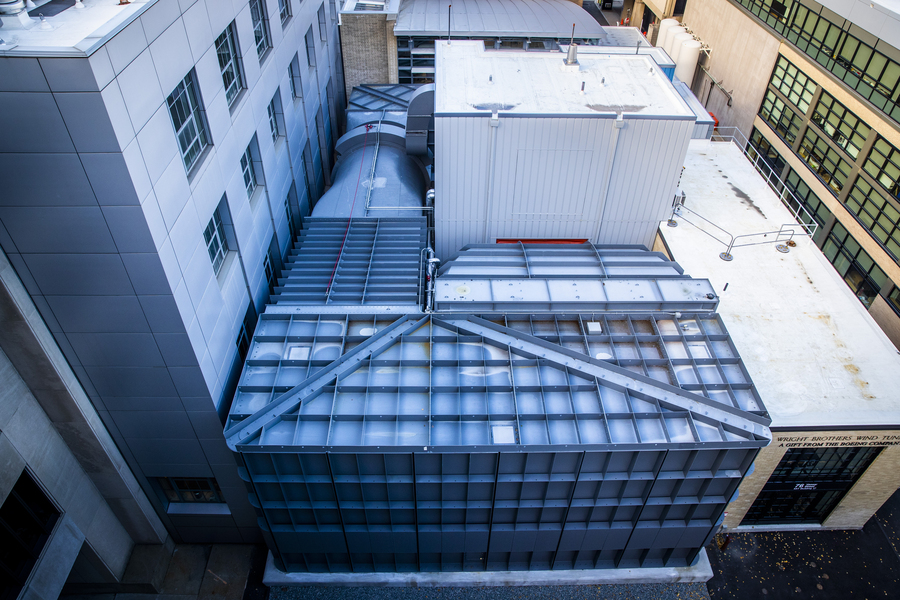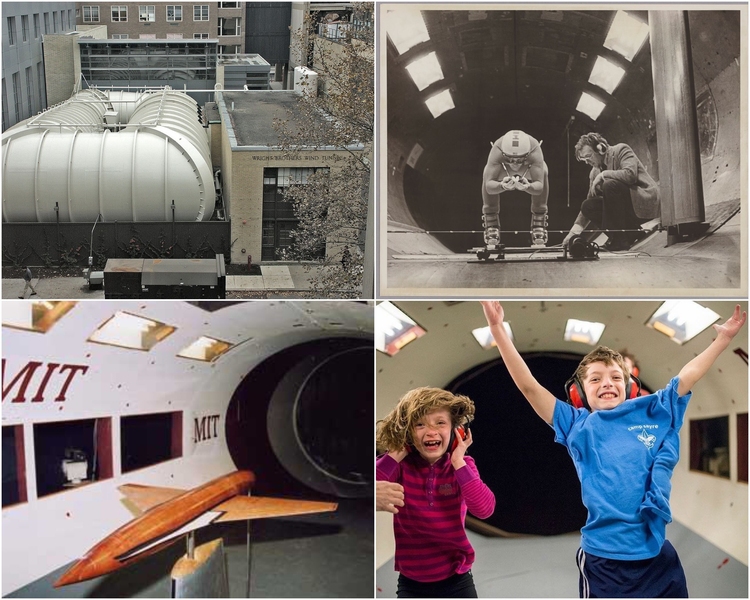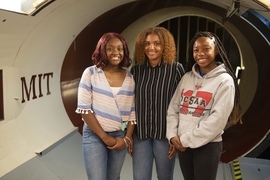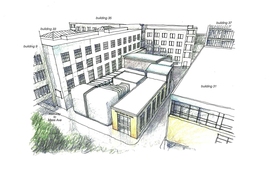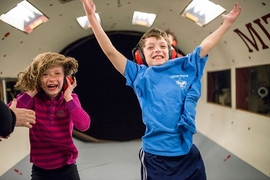When Mark Drela first set foot in Cambridge to study aerospace engineering at MIT in 1978, he was no stranger to wind tunnels. Just two years before, he constructed a 1-foot-by-1-foot wind tunnel for the Westinghouse Science Talent Search that earned him a visit to the White House as a finalist. But nothing could have prepared him for the first time he saw the iconic Wright Brothers Wind Tunnel, a moment that would tie into his later career and eventually impact the very fabric of MIT's campus.
“It was my very first day on MIT's campus, so I was just wandering around when I turned the corner and saw it — whoa! A wind tunnel! And it's a big one!” says Drela ’82, SM ’83, PhD ’85. “I had no idea it was even here. I ran up and knocked on the door, and [longtime tunnel operator] Frank Durgin answered. He was the first AeroAstro person I met on campus, and he could see how excited I was, so he gave me a tour.”
Since its dedication in 1938, the Wright Brothers Wind Tunnel has become a campus landmark used for education, research, industry, and outreach. Still, by the time Drela had his fateful first encounter, it was already showing its age. In 2017, the MIT Department of Aeronautics and Astronautics (AeroAstro) announced it would replace the tunnel with a brand-new facility thanks to a lead funding commitment from Boeing with Drela, now the Terry J. Kohler Professor and director of the Wright Brothers Wind Tunnel, at the helm.
Today, MIT is home to the most advanced academic wind tunnel in the country, capable of reaching wind speeds up to 230 miles per hour (mph), with the largest test section in U.S. academia.
“If I had one word to describe the state of the old tunnel after 80 years, it would be decrepit. The tunnel shell and supporting foundations, the instrumentation, and the drive motor and fan were all in a state of decay. The airflow quality was poor, and the tunnel was extremely loud and power-inefficient,” says Drela. “It just wasn't holding up against our modern standards of wind tunnel testing. Our goal was to bring our vintage tunnel into the 21st century and beyond, and we did that.”
Go with the flow
Wind tunnels have been in use for more than 150 years — even Wilbur and Orville Wright tested candidate wing designs in a simple open-ended wind tunnel they constructed before their historic flight in 1903. Nearly everything on the Earth’s surface has air flowing over it. Instead of moving an object through the air, wind tunnels move air over a stationary object in a controlled environment, allowing the operator to take aerodynamic measurements. When building something that needs to interact with airflow, it's necessary to understand and predict the aerodynamic forces in that interaction to diagnose and fix any problems or shortcomings in the design.
Wind tunnel measurements can determine how much fuel an aircraft will consume, how slowly it can fly during landing, or how much control it has in maneuvers. But wind tunnels are not limited to aerospace applications. They can also measure the aerodynamic loads on ground vehicles, such as cars and bicycles, or wind loads on stationary objects, such as bridges and buildings. Scientists and engineers also use wind tunnels for fundamental research, like studying how the air behaves when it interacts with an object to understand the science of fluid mechanics.
Uses for the Wright Brothers Wind Tunnel continued to evolve throughout its 80-year history. During World War II, the U.S. government took over the Wright Brothers Wind Tunnel for days to perform top-secret aircraft research and development. Over the years, in addition to aerospace research, investigators used it to test ski and bike equipment, analyze city landscapes, and even demonstrate how a 130-million-year-old four-winged dinosaur might have flown, for a documentary film.
Beyond its use in research, educators also used the tunnel extensively for coursework and public outreach. But after nearly eight decades, the aged equipment became a challenge to use. A full replacement was in order, and thanks to its urban campus home, the project presented several unique challenges.
“To have the best facility possible, we knew we needed a large test section with very good airflow quality and a maximum speed of at least 200 miles per hour, which dictated a large tunnel size and a powerful drive motor,” says Drela. “But since the tunnel sits right in the middle of campus, we had to achieve these goals while making it compatible with our urban environment. When your goals massively conflict with your constraints, you get an incredibly challenging project.”
Innovating convention
In general, nearly all wind tunnels aim to generate “clean” airflow, which means uniform flow with a constant velocity, free from distortion or turbulence. The convention would dictate a large tunnel for the required test-section size, which paradoxically requires less power to produce higher airflow quality while generating less noise. But for the Wright Brothers Wind Tunnel, size was not an option.
“Like any engineering project, size and cost were major considerations. We couldn’t just take the design of a conventional tunnel and size it to fit into the old tunnel’s relatively small space and expect it to work,” says Drela. “We had to design an entirely new architecture with many innovations to the fan, diffusers, contraction, and the corner vanes to give the new tunnel our desired capabilities within the limits of the old tunnel’s existing footprint.”
Both the old and new Wright Brothers tunnels are closed-circuit types, where the air flows through the tunnel's test section for measurement-taking before recirculating around the tunnel again. But that is where the similarities end.
One of the most distinctive visual differences between old and new is the design of the fan itself. The old fan followed convention still commonly seen today: a 13-foot diameter with six blades made of wood that resembled boat oars. The 2,000-horsepower motor could only run at four fixed speeds, and the operator adjusted the airflow speed by varying the fan's pitch mechanically. As a result, the system was complex, and the fan was noisy to operate. To mitigate these issues in the new tunnel, Drela worked with wind tunnel vendor Aerolab to conceive and manufacture an entirely new design: the Boundary Layer Ingesting (BLI) fan.
Air flowing over an object has a layer of slow-moving air over the object’s surface caused by fluid friction called a boundary layer. Consequently, the airflow inside a wind tunnel has boundary layers over the entire inner surface of the shell. In the test section, where the airflow is cleanest, the boundary layer is only a few inches thick, but it grows as the airflow moves downstream. By the time it enters the fan, the airflow has a thick boundary layer extending over approximately half the length of each fan blade. Traditional wind tunnel fan design typically ignores the boundary layer, opting to eliminate it by mixing it with the rest of the flow farther downstream. But with 17 uniquely-shaped blades and a 16-foot diameter, the BLI fan is specifically designed not only to accommodate this inflow nonuniformity, but to exploit it.
“The flared tips of the fan blades add extra work to the boundary layer where the velocity is lowest, near the wall,” says Drela. “Using the fan to remove this velocity nonuniformity requires less power than the downstream mixing in all other wind tunnels. The resulting flow that exits the fan is uniform, further reducing the power losses in the downstream portion of the tunnel.”
The BLI fan is driven directly by a 2,500-horsepower motor, so the overall drive system in effect has only one moving part — a significant improvement over the mechanically complex variable-pitch drive of the old tunnel. A variable frequency drive controls the motor speed, making it more power-efficient and quieter than the old tunnel's system.
The fan pressurizes most of the tunnel flow circuit, resulting in the tunnel's far wall opposite the fan withstanding up to 80 tons of load when the tunnel operates at full speed, equivalent to the force of a 240-mph hurricane. To accommodate the resulting elastic flexing of the walls, the only parts of the Wright Brothers Wind Tunnel anchored to the ground are the fan and the test section. The remainder of the tunnel has sliding and rocking supports, allowing the tunnel to “squirm” in place up to 1 centimeter, alleviating significant stress generated from the pressure loads and temperature variations.
After the flow leaves the test section, it turns through corners one and two, then passes through the fan, after which it goes through a heat exchanger to regulate the air temperature, which is then followed by corner three. Up until this point, this is a standard process in most current wind tunnels, but according to Drela, the final corner four “is where the real magic happens” in the Wright Brothers Wind Tunnel.
While the first three corners have vanes that only turn the airflow 90 degrees, corner four not only turns the flow but also expands its area while slowing it down significantly, enabled by a screen and aluminum honeycomb diffusers installed in the passages between the vanes. Performing the same flow-deceleration and straightening in a conventional tunnel requires more space and separate honeycomb filters and screens. By combining these components into the single corner vane row, the Wright Brothers Wind Tunnel achieves the same flow turning, deceleration, and straightening functions with minimal added space.
“If we didn't have the screen expanding turning vanes suppressing the wall boundary layers in corner four, they would ‘burst’ or separate after the corner, thus filling the entire flow path and making the air slosh around like in a washing machine. The resulting flow going into the test section would be very messy and unusable for aerodynamic tests,” says Drela. “The screened expanding turning vanes at corner four are arguably the most important components of the new tunnel because it allows for a large flow area expansion in no added space while maintaining a nearly uniform flow.”
Although the airflow exiting corner four is relatively clean, it next passes through four flow-conditioning screens to make it even more smooth and uniform. Immediately after the final screen, the air enters the contraction, the widest part of the tunnel that accelerates the flow into the test section. A key parameter to indicate the efficiency and quality of a wind tunnel is the contraction ratio, which is the ratio of the airflow velocity between the test section and after the flow-conditioning screens. The old tunnel had a contraction ratio of 4.5:1, but Drela wanted to reach the “sweet spot” by increasing the ratio in the new one to 8:1.
“For the new tunnel, we used computational fluid dynamics to carefully design a minimum-length contraction by combining it with the usual settling chamber after the screens,” says Drela. “This combination saved us about eight feet of space, which was significant for a tunnel that is only 96 feet in total length.”
In the test section, an object is mounted on a slender post connected to the main force balance, which is the instrument installed immediately under the test section floor that senses and reads the aerodynamic forces as the airflow interacts with the model. The test section size and shape in the Wright Brothers Wind Tunnel are other significant improvements when comparing old and new. The old test section only had 57 square feet (ft2) of flow area, and its elliptical shape meant it had a cramped floor that was only 12 feet long. By comparison, the new test section has 90 ft2 of flow area, and its rectangular cross-section is 18 feet long with a floor two times wider than before. A bigger test section can accommodate larger models, which is beneficial for collecting more accurate data while improving user experience significantly by allowing plenty of workspace for the researcher.
The new tunnel also features a new MATLAB-based tunnel control and data acquisition system. This system combines the typical functions of manual tunnel operation, control, and data collection into a streamlined, fully customizable platform. The test section’s glass walls and ceiling windows give extensive optical access, which enables laser-doppler velocimetry and particle-image velocimetry measurements as well as optical model motion tracking. Safety and security features are also built directly into the tunnel control system, monitoring tunnel health parameters such as temperatures, pressures, and vibration levels. The system automatically switches to rapid shutdown mode if any health parameter exceeds its preset physical limit, or in the event of a manual emergency stop.
“You can control everything through this interface — tunnel speed, model positioning, instrument interrogation, data display, logging, and more — all from the same place,” says Drela. “It removes as much human error from the process as possible. Since the system is watching your back, you literally cannot do anything to break the tunnel from the keyboard, which is very comforting from the user's perspective.”
Breaking new ground
Construction for the Wright Brothers Wind Tunnel project broke ground in fall 2019. It was completed 22 months later in tandem with a complete renovation of Building 17, which used to exclusively house the wind tunnel control room and the headquarters for the MIT Rocket Team.
The Building 17 renovation overhauled these spaces, combined them with the Gerhard Neumann Hangar and Laboratory (formerly housed in Building 33), and added meeting rooms and research laboratory space. Historic buildings come with inherent renovation challenges. Toxic materials like lead and asbestos tend to come standard in old buildings. Delivering massive tunnel components to the job site meant carefully maneuvering the tight squeeze between campus buildings. But the global pandemic was a curve ball that no one saw coming.
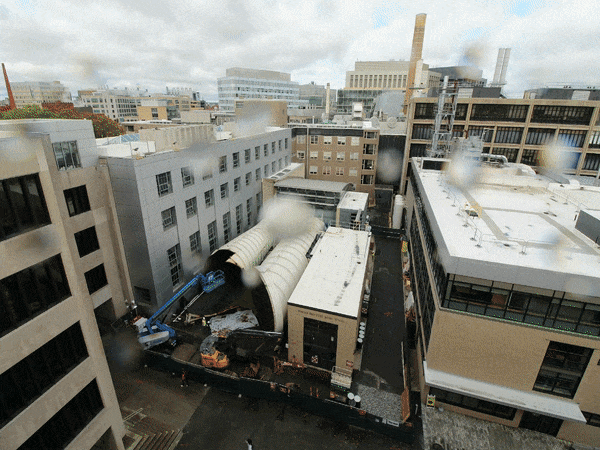
“Safety is always a top priority on any construction site. The coronavirus situation took it to another level, especially with the Cambridge-wide moratorium on construction projects that lasted for weeks,” says Anthony Zolnik, manager of infrastructure for AeroAstro, who represented the department on the project management team. “Thankfully, we had an amazing team, both within MIT and our external vendors, so we could work together to add additional measures to keep the workers safe. I'm happy to say that we made it through without any outbreaks, and we were able to keep the construction progress on track.”
Boeing's generous contribution to the project reflects a long-standing relationship between the company and MIT, representing how collaborations between academia and industry have helped aerospace evolve into a global economy today.
“Boeing’s work with MIT dates back more than a century — but in today’s world, that collaboration is more critical than ever,” says Greg Hyslop, chief engineer of the Boeing Co. and executive vice president of engineering, test, and technology. “No one entity can meet the need for scalable innovation, and the value that academic research brings to our industry is nearly incalculable.”
In addition to support from Boeing, the Wright Brothers Wind Tunnel replacement and Building 17 renovation were made possible thanks to gifts from Becky Samberg and the late Arthur “Art” Samberg ’62 and MathWorks for the MIT Wind Tunnel Instrumentation Platform Project, which is helping MIT build and operate a state-of-the-art modern data test driver and data acquisition system.
Even though the cranes and bulldozers have left the site, the team continues to make final calibrations to the instrumentation and other finishing touches in order to reach full operational capacity by midsummer. At that time, the Wright Brothers Wind Tunnel will be open to the outside world for industry testing, scheduled tours, and more. Planning is already underway for the fall semester, and Drela will incorporate laboratory activities in the tunnel to complement the coursework for the classes he oversees.
In keeping with its predecessor, the new tunnel will carry forward an important legacy representing AeroAstro in outreach efforts across MIT and to the public. Other MIT instructors used the previous tunnel to teach classes and student groups for testing various club equipment. It has always been a popular attraction during campus events, where visitors can step into the test section and experience the wind tunnel in action with the air blowing at a breezy 30 mph.
“We’re looking forward to bringing this sense of excitement back to campus since it’s been on hiatus due to construction and the pandemic,” says Daniel Hastings, associate dean of engineering for diversity, equity, and inclusion at MIT; head of AeroAstro; and Cecil and Ida Green Education Professor. “As we conclude this project, we find ourselves once again at the forefront of academic wind tunnels, which will allow us to deliver world-class capabilities to further education, research, and industry while creating unique, immersive experiences that will inspire future generations of engineers and scientists.”
According to Drela, even in the age of advanced computing, simulation, and modeling, practical testing in wind tunnels is just as valuable as ever, especially when paired with these advanced techniques.
“Even with the most advanced computer, we can't calculate flow with adequate precision or confidence or without significant margins of error, which could be catastrophic in some circumstances. For example, if you significantly underestimate stall speed, a crucial aspect of airplane performance, it's the difference between life or death,” says Drela. “While there are situations where I wouldn't trust calculations over measurements, wind tunnel testing and computation are extremely complementary. Experimental data obtained in wind tunnels will always be indispensable for validating a theoretical and computational fluid flow model.”
